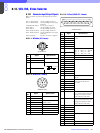
9
Chapter 9 Glossary – Terms and Definitions 175HDC-900/950/930 Series Product Information Manual
Pedestal/Master black
It is the black level. If the pedestal level is too high, the
whole picture will become a little bit white.
Prism block for color separation
A prism block that breaks down sunlight into red,
green, and blue - the three element colors for a video
image - is an essential component for a CCD camera.
Skin tone DTL
Skin tone DTL is a function that changes the DTL value
by color. It was originally designed to make an
announcer’s face more lustrous by reducing the DTL
on his/her face. It is also a useful function for
intentionally emphasizing certain scenes such as the
surface of a lawn.
System conversion
In addition to HD output, NTSC and PAL outputs are
also necessary for HD cameras. For that, the CCU
uses a down converter.
Vertical image enhancement (V DTL)
Vertical image enhancement is performed by
enhancing the difference between vertical picture
elements using a 2H delay line.
White balance
White balance is used to compensate for the color
temperature of the subject for photography. Contrarily,
a sunset scene can be taken even in the daytime by
using the white balance adjustment.
White clip/Black clip
The range between black level and the maximum white
level is fixed in video signal standards. The white clip
and black clip are the circuits used to prevent video
signals from exceeding this range.
White shading correction
Because irregular shading happens during light-to-
current inversion in a CCD, sensitivity becomes
uneven on the screen. It is not so conspicuous for a
one-chip camera, but for a three-chip camera
sometimes the color may not be completely the same
depending on the portion of the screen. White shading
correction is used to avoid this phenomenon that is
also called modulation shading.
9-2. Software
Software plays an important role in cameras today. It is
not too strong to say that a camera without software is
just like a body without a brain. Usually, software is
integrated into switches for internal setting or for
communications with other devices. The following are
some technical terms we frequently use in this field.
Auto black balance (ABB)
Auto black balance automatically adjusts the black
level to prevent coloring other than black, which
occurs while the lens is closed. Sometimes, black set
is also carried out at the same time. Some CCD
cameras use APR (Automatic Pixel Restoration) to
perform auto black balance for convenience.
Auto Iris
Auto iris is a function that automatically controls the
aperture (lens opening) based on the mean or the
peak value of video signals.
Auto set up
Auto set up is a function for camera automatic
adjustment which can be divided into Auto White
Balance (AWB), Auto Tracing White (ATW), Auto Black
Balance (ABB), Level Auto Setup, Auto White Shading,
Auto Black Shading, etc.
Auto tracing white (ATW)
It is a convenient function for low-end or consumer
type cameras, which automatically keeps adjusting the
white balance during shooting. However, most of the
cameras used for broadcast applications do not adopt
this method because the white balance is not very
precise and the ongoing changing of color
temperature is not usually a variable to consider
because scenes are staged and controlled.
Auto white balance (AWB)
Auto white balance automatically adjusts color
temperature when shooting a white subject.
Auto white shading/Auto black shading
Both of them automatically adjust the shading. Auto
black shading is simply carried out when the lens is
closed. However, in the strict sense of the word, a
complete white subject for photography is needed for
auto white shading, in which there are two modes - one
keeps each of the R/G/B waves flat and the other
matches them to the G-channel.
File system
Increasing camera functions also expands the number
of its setting items. In order to improve the operability
and make it easy, setting and correction information
are stored in the files in the camera, while the reference
and scene files are stored on a memory card.
Lens file
Lenses of the cameras for broadcasting use are often
changed to meet different shooting environments.
Since each lens has its own characteristic, individual
settings and adjustments have to be done every time
the lens is changed. In order to improve the operability,
a lens file is developed to store the setting data that
can be recalled so to skip over the process of setting
and adjustment to save time.
Level auto set up
Level auto set up is a function that automatically keeps
adjusting the camera to a standard setting, e.g.
automatically adjusting gamma, knee, etc.
Pattern auto iris
Pattern auto iris is used to emphasize auto iris on
certain portions of the screen, e.g. granting priority to
the center portion, cutting the upper portion, or
emphasizing the center.
Reference file
A reference file is a place to store setting data for
normal status that varies depending on the user’s
individual settings. The data is also the target value for
“level auto set up” including not only the analog control
data but also the digital file data for switch settings.


















